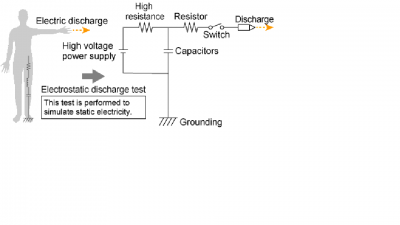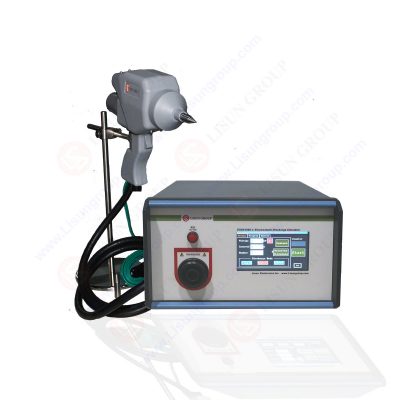A crackling sweater hair that sticks straight out from your head, a small electric shock from a door handle. We are more familiar with those moments when there is a discharge of static electricity. This phenomenon is known as Electrostatic Discharge or ESD.

ESD testing
Electrostatic Discharge (ESD) testing is defined as the EMC Tests applied for electrical products. It is an electromagnetic compatibility testing, and it is categorized as immunity testing. ESD signal is specified by the standard applied to equipment under the test with a voltage level.
These guns are used to generate the signal or the waveform. The gun generates the waveform given in the relevant ESD standard. Their calibration verifies the accuracy of ESD guns before the ESD testing. Guns have multiple versions according to their maximum voltage capabilities.
The gun’s batteries can be charged. Additional batteries can be used, or we can supply them directly from the mains. ESD guns have two different types of tips; Contact and Air (mostly, they are replaceable). During the testing, these guns are held by the test expert. Ergonomic ones are recommended.
The ESD standard is chosen according to EUT. These pulses are applied to the EUT’s in laboratory environments. If equipment under test fulfils the performance levels, the result is passed. Otherwise, the equipment under the test does not fulfil the standard. Mostly used standards are IEC 61000-4-2 and ISO 10605. Air or contact tip is plugged into the gun, and discharge is applied to the selected points on the gun.
ESD Simulators are used for the indication of test levels, waveform requirements, and the design of the equipment. The devices used to determine the voltage, current, and capacitance during the ESD testing are called ESD guns.
LISUN has manufactured the best electrical equipment. ESD simulator (ESD 61000-2) is a precision high voltage instrument. The internal design of the equipment possesses a protection mechanism.
Occurrence
ESD often occurs in everyday situations like walking on a carpet or in old plastic shoes. When this happens, the negative electrical charges are picked up and distributed across the entire surface of the object or body. If the contact is made with another conductive body or ground, this charge suddenly flows off. It will be possible to feel, hear and see this phenomenon in the form of a spark or a flash voltage of over 10,000 volts.

ESD61000-2_Electrostatic Discharge Simulator
• Quantify the signal range of your signal/ power interference to determine the ESD diode’s working voltage.
• Decide whether a unidirectional or bidirectional configuration is preferred.
• Decide the maximum capacitance that can be accepted for the interface.
• Determine the TLP voltage the system fails at to determine the necessary clamping voltage of the diode.
• Ensure that the diode exceeds IEC 61000-4-2 level 4.
• The first step is to have a look at the voltage range of the lines. For USB 2.0, you should go as high as 5 volts.
• So, the working voltage of the ESD diode must be 5 volts or slightly higher than 5 volts.
• The D+/D- lines transmit the data with a differential signal that falls between 0 to 3.6 volts during the normal operation.
• Therefore, the working voltage must be at least 3.6 volts or slightly higher.
• Next, we need to decide what ESD polarity configuration we should prefer.
• In this application, both the unidirectional and bidirectional diodes would be suitable because the Vbus and D+/D- voltages are always greater than or equal to 0 during normal operation.
• Unidirectional diodes often provide better negative clamping gear. Single-channel bidirectional ESD diodes would offer the flexibility of connecting any pin to the ground, and the other pin should be connected to I/O since it is symmetrical.
• The same would apply to the D+ and D-.
After determining the voltage, we need to determine the capacitance the ESD diode should have.
• Since the Vbus is a DC power signal, the capacitance will not affect its performance. However, the D+/D- can reach up to 480 megabits per second for high-speed USB, so capacitance should be considered.
• The maximum ESD capacitance will depend on the overall system capacitance budget. Generally, we recommend diodes with more than 2.5 picofarads of capacitance for this interface.
• You may need a lower cap if the system has more capacitance than the required one.
• Let’s assume that the battery charger will fail at a TLP pulse of 20 volts. The USB switch will fail at a TLP pulse of more than 15 volts.
• It means that to protect the battery charger from an 8kv ESD strike, the ESD diode must have a clamping voltage of fewer than 20 volts at 16 amps TLP.
• Likewise, the ESD diodes must have a clamping voltage of fewer than 16 volts to protect the USB switch, like 16 amps TLP.
• It is important to note here that the TLP failure voltage of a device is not as same as the absolute maximum voltage rating of the device.
• The absolute maximum voltage is DC, while TLP is a 100-nanosecond transient. The clamping voltage of a system is not always an easy one. In order to save time, LISUN has created several selection tools and guides to recommend the solutions based on the interface.

Electric or electronic equipment circuits get damaged because of the static electricity generated by the human body to an object or between the two objects. We use an ESD generator to access the electrical and electronic equipment withstanding ESD performance measurement. ESD 61000-2/ ESD 61000-2A comprises an LCD touch screen in English and CHINESE.
An Electric Discharge Simulator is the highest electrostatic voltage that can be up to 30 VK.. It is enough to cover the most severe standard grade of an electrostatic voltage requirement. The ESD test gun is used in the electrical and electronic equipment to conduct an electrostatic discharge test. We can also use it to ensure the test’s compatibility and reproducibility.
Lisun Instruments Limited was found by LISUN GROUP in 2003. LISUN quality system has been strictly certified by ISO9001:2015. As a CIE Membership, LISUN products are designed based on CIE, IEC and other international or national standards. All products passed CE certificate and authenticated by the third party lab.
Our main products are Goniophotometer, Integrating Spheres, Spectroradiometer, Surge Generator, ESD Simulator Guns, EMI Receiver, EMC Test Equipment, Electrical Safety Tester, Environmental Chamber, Temperature Chamber, Climate Chamber, Thermal Chamber, Salt Spray Test, Dust Test Chamber, Waterproof Test, RoHS Test (EDXRF), Glow Wire Test and Needle Flame Test.
Please feel free to contact us if you need any support.
Tech Dep: Service@Lisungroup.com, Cell/WhatsApp:+8615317907381
Sales Dep: Sales@Lisungroup.com, Cell/WhatsApp:+8618117273997
Your email address will not be published. Required fields are marked *